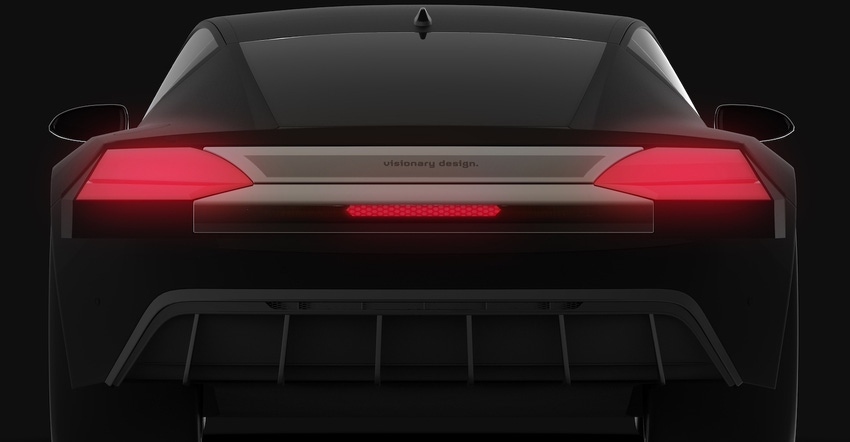Dual-component injection molding with in-mold decoration produces stunning effects from a single-step production process.
September 23, 2022

When one considers the vehicle of tomorrow, we imagine futuristic exterior brand design, 3D lighting effects, and intelligent functions, even on the exterior. All of this is already possible today, as thin-film specialist Leonhard Kurz will soon demonstrate in cooperation with injection molding machine builder Engel. They have pooled their expertise and will present a future-proof design concept for vehicle rear areas at K 2022 in Düsseldorf, Germany, from Oct. 19 to 26.
2K material mix opens up new possibilities
A new machine and process technology that enables the use of a 2K material mix was developed in tandem with Kurz subsidiary Schöfer.
The term 2K signifies “dual-component injection molding with in-mold decoration (IMD) technology." Two different plastics are used — acrylonitrile butadiene styrene/polycarbonate (ABS/PC) and transparent thermoplastic polymethyl methacrylate (PMMA). “This special blend of materials allows us, for example, to provide backlighting with targeted light separation, without any undesirable light diffusion. This is the series-ready answer to market requirements in terms of multi-component technology,” explains Martin Hahn, Head of Application, Technology, & Innovation at Leonhard Kurz’s Plastic Decoration business. “And best of all, thanks to our careful choice of materials, the components can later be mechanically recycled together. This means that they can be reused as a post-industrial recyclate.”
Reduced production complexity
The complex technical application is based on Schöfer’s high-end “spin stack mold” technology, which is suited for the production of ready-to-install components in large dimensions. It enables the use of IMD technology in combination with the 2K material mix, allowing for the implementation of three-dimensional component geometries and structures for 3D light effects and light barriers in a single step. Manufacturers benefit from reduced production complexity that eliminates the need for deep drawing, punching, or stacking.
Kurz and Engel will demonstrate this process at K 2022 at the Kurz booth (A19 in hall 5), where an Engel machine will mold rear-end covers. This component harmoniously combines design and functionality, says Kurz. The connected surface impresses with its seamless decoration, backlighting, and 3D lighting effects. “This means that the rear-end cover also facilitates communication with other road users,” explains Hahn. “Further highlights are only revealed at a second glance. The possible integration of touch operation offers, for example, activation of a Shy Tech charge level indicator for e-cars. The component is also permeable to radar waves and supports the latest driver assistance systems, right through to autonomous driving.”
Individually tailored production platforms
Thanks to advanced one-shot production, all processes can be implemented in a single work step. “This is made possible by the combination of injection molding, IMD, and high-end insert technology from Schöfer. For manufacturers, this means time- and cost-efficient production while simultaneously reducing CO2 emissions,” explains Hahn.
He continues: “Our goal for the future is to develop a production platform for our customers that can be individually tailored to different project requirements. This year, we are demonstrating the further development of our IMD Decopur technology, which Kurz introduced back in 2019. This platform enables us to combine 2K thermoplastic technology with Decopur. This not only opens up different combination possibilities, but also offers smart manufacturing efficiency with low energy consumption.”
The duo 1300 Combi M machine from Engel is matched to the application at hand. “To enable the use of multi-edge cutter technology, the duo 1300 Combi M has a second moving injection unit on the movable clamping plate. The center mold halves are rotated using a horizontal turn table with a vertical adapter plate,” explains Michael Fischer, Head of Business Development Technologies at Engel. “The articulated robot of the Engel easix KR120 series takes care of the demolding and supports the decoration step beforehand with the additionally installed heating mirror. We have ideally coordinated all components, including the integration of Engel temperature control technology, to make production as efficient as possible.”
Kurz and Engel have sought further support for this ambitious project. In addition to tool maker Schöfer, structure expert Reichle as well as materials suppliers Sabic and Röhm are involved. Burg Design, also a Kurz subsidiary, rounds out the team of partners.
You May Also Like


